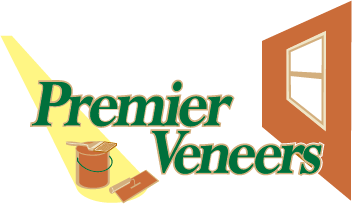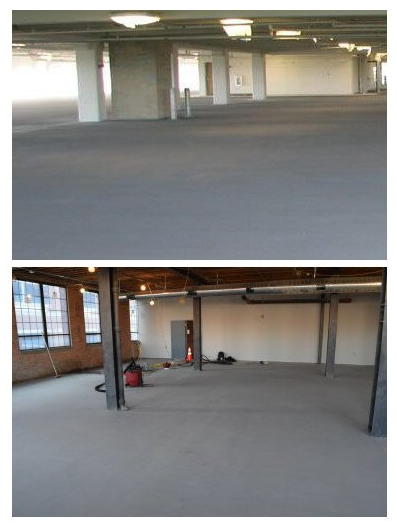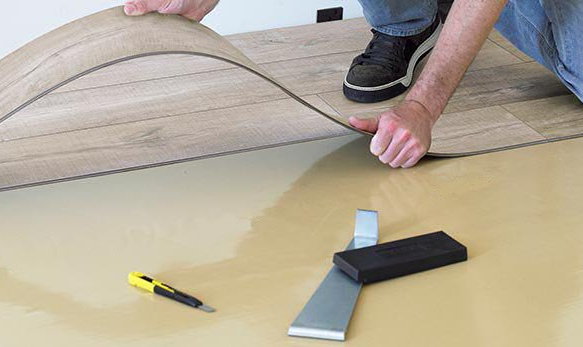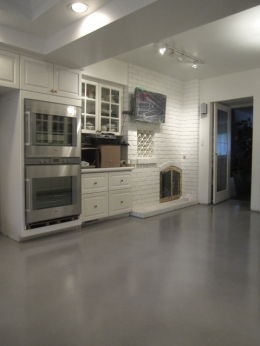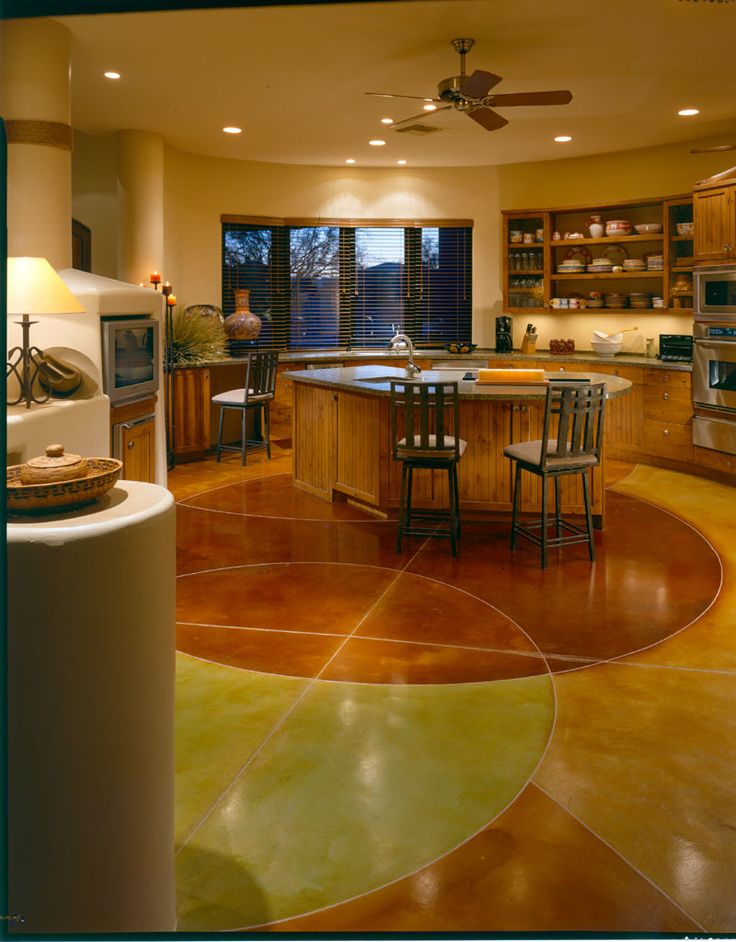Most people, even in construction, remodeling and flooring, have probably never heard the term, “self-leveling overlay” - let alone similar terms, like “self-leveler”, “floor leveler” or “concrete leveler”. However, based on the number of inquiries we receive about self-leveling overlays, it is clear to us that, while many people may not know what self-leveling overlays are, they do realize they might be able to use one on a flooring project for their home or business.
That, coupled with the fact that self-leveling overlays continue to expand in use with decorative concrete flooring, makes this an important issue. Self-leveling overlays have been around for around 30 years, now, and they are routinely used with decorative concrete flooring, for example, in acid staining, and with waxes and clear sealers. But they are also beginning to be used more earnestly with newer decorative options, such as polished concrete and concrete countertops.
SELF-LEVELING OVERLAYS DEFINED
In essence, a “self-leveling overlay” is a cement-based compound, similar to a thick coating, like epoxy, that goes down over an existing concrete (or wood) subfloor to create a new, hard, durable and extremely flat, flooring surface. Once dry, a self-leveling overlay can be covered with a traditional flooring material, like carpet, tile, hardwood or laminate; or it can be sealed, and left exposed, to use as a wear surface, because its cement composition gives it a hardness and durability meeting or exceeding that of normal concrete.
Self-leveling overlays and normal concrete look almost exactly alike. At top is newly poured concrete in a parking deck; at bottom, a new self-leveling overlay of an old warehouse concrete floor.
Similar to concrete, self-leveling overlays also contain fine aggregate, like silica or quartz; may contain pozzolans, like fly ash or slag; come in gray or white; and are mixed with water. However, that’s where the similarity between concrete and self-leveling overlays generally ends. Unlike concrete, which is normally placed at thicknesses of 4” or 6” for a flooring slab in a new home or business, self-leveling overlays are put down very thin - most of the time between ¼” and ½” - and they do not noticeably change the elevation of the existing subfloor.
The reason self-leveling overlays can be placed so thinly is they contain a polymer additive, such as vinyl acetate or polyacrylic ester, that gives them greater cohesive strength than concrete. This polymer additive helps the cement in the overlay material hold together much better and not crumble like ordinary concrete would if it was placed so thinly. This is commonly referred to as “tensile strength”. The polymer additive also gives cement overlay material greater flexibility - or “flexural strength” (something concrete doesn’t have much of either) - so that it doesn’t crack.
In addition, because self-leveling overlays don’t contain medium- or large-sized aggregate, like gravel or stone, which is a significant source of the overall strength of concrete, they make up for this through the use of special, “engineered” cements, such as calcium aluminate, that are much harder, and set up much faster, than traditional Portland cement. Self-leveling overlays also use twice as much of these cements as the 10-15% Portland cement composition normally found in concrete, and they use higher quality fine aggregates to give the final surface a smoother and more consistent appearance.
The addition of only several ounces of liquid "polycarboxylate", per hundred pound bag of cement, is required to make "self-consolidating concrete" (SCC).
Lastly, self-leveling overlays contain flow modifiers, or “plasticizers”, that help them spread out quickly, and level on their own, when poured onto a floor, and therefore require minimal finishing. The plasticizers used in self-leveling overlays, however, are more complex than those typically used in coatings, rubber and concrete, and are usually referred to as “superplasticizers”. One of the main superplasticizers used in self-leveling overlays is a polymer called, "polycarboxylate". Polycarboxylate was introduced into the U.S. in the mid-1990’s, with the use of “self-consolidating concrete” (SCC), of which it is also a key ingredient.
OVERLAYS DIFFER FROM UNDERLAYS
Besides the differences with concrete, self-leveling overlays also differ significantly from self-leveling “underlays”. This is an important point to keep in mind because these two categories of products are often grouped together, and sold, in the same sections on manufacturers’ websites, and because overlay manufacturers continue to modify and expand the features and characteristics of both self-leveling “overlays” and “underlays”, and in doing so blur the distinctions between them - similar to the way the differences between smartphones and desktop computers have greatly diminished over the past decade with the introduction of “laptop” computers, “notebooks” and “tablets”.
Broadly, self-leveling overlays and self-leveling underlays differ in five key respects: 1) function; 2) quality of composition; 3) strength; 4) thickness; 5) use of primer; and 6) expense.
Self-leveling underlays always have floor coverings, like luxury vinyl tile, installed over top. This ensures full adhesion and prevents corners and edges of tile (and hardwood) from sticking up or coming loose.
First, regarding function, the word “underlay” is an abbreviation for “underlayment”, a construction term developed in the mid-1940’s, which refers to "a smooth layer between a subfloor and finished floor that facilitates leveling and adhesion”. More specifically, an "underlay" is a middle layer of flooring that is supposed to be covered by another material, typically, a "floor covering", like carpet, tile, hardwood or laminate. Underlays are not meant to be exposed, or used as a final “wear surface”, since unlike self-leveling overlays, they may easily chip, scratch and crumble upon blunt force contact.
Second, because self-leveling underlays are not designed to be used as a final “wear" surface, the quality of this product and the ingredients used in manufacturing it is substantially inferior to that of self-leveling "overlays". For example, instead of using special “engineered” cements, self-leveling underlays use softer, more common materials, like gypsum (used in drywall), calcium sulfate (used in plaster), and in some cases, just ordinary Portland cement. Self-leveling underlays also contain lower quantities of these "cements" and lower quantities (and quality) of polymer additives. This affects the final quality of the finished appearance of the floor surface.
Third, because self-leveling underlays are not designed to be used as final “wear” surfaces, and therefore stand up to foot traffic and other exposure conditions, they are not as strong as self-leveling overlays. While the hardness, or “compressive strength”, of self-leveling overlays almost always exceeds 5,000 psi, and may reach as high as 6,000 psi, self-leveling underlays usually range from only 2,500 to 3,500 psi in compressive strength, and rarely above 4,000 psi. Similarly, self-leveling underlays also have 30-50% less flexural strength than self-leveling overlays, meaning that they will crack much easier under stress from or movement by the concrete or wood subfloor.
This bedroom flooring shows the kind of cracking and chipping that is likely to happen with a self-leveling underlay. The defects in this flooring will only grow worse over time.
Fourth, since self-leveling underlays are of inferior quality than self-leveling overlays, and are not designed to be as strong, they cannot be placed at the same depths. The maximum depth, or thickness, at which a self-leveling underlay generally may be placed is approximately 1". Self-leveling overlays can normally be placed up to 2" thick, in one layer. In order to reach a depth of 2", self-leveling overlays can also be, and sometimes are, placed in two equal layers, or "lifts"; this increases the overlay's overall resistance to cracking. The same cannot be done with underlays. So, for example, with a floor that is out of level by more than and inch, even if a floor covering is going to be installed over top, a self-leveling overlay must be used.
Fifth, self-leveling overlays and self-leveling underlays both require application of a primer coating to promote their adhesion and to prevent loss of moisture from the material to the substrate. Where self-leveling overlays differ is in requiring the use of higher quality primer, normally epoxy, and its more careful application, such as using multiple coats, cross-rolling and the broadcasting of sand, to create a stronger bond and to prevent air bubbles from coming to the surface. An average bond strength, and the possibility of small bubbles or pinholes, are not a problem with self-leveling underlays, since the final surface will be covered by another material.
Sixth, because self-leveling underlays are not as strong as self-leveling overlays, use lower quality ingredients and don't need to look great, since they will be covered by another materials, they are also less expensive. For example, whereas self-leveling overlay material might cost between $45 and $70 for a 50-pound bag, a similar quantity of self-leveling underlayment will only cost from $25 to $40, or at least $20 less per bag. Since self-leveling underlays only require an acrylic or vinyl composition primer coating, instead of an epoxy-based one, that cost is considerably less, also. Vinyl and acrylic primers normally cost only $20-25 per gallon, as opposed to $60-100 per gallon for the epoxy primers used with self-leveling overlays.
OVERALL PURPOSES AND ADVANTAGES OF SELF-LEVELING OVERLAYS
A self-leveling overlay is a blend of special cements, fine aggregate, polymer and superplasticizer designed to go down in a thin, durable, smooth layer hard enough to be used as a wear surface that doesn’t require covering by another flooring material. But in what situation, and under what circumstances, would you want to use a self-leveling overlay? This is an important question because there are various types of cement overlays that require various, different methods of application. Self-leveling overlays are only one such type of cement overlay. However, they provide unique features and advantages that other types of cement overlays - for example, those that are troweled down, or sprayed - do not.
Ardex SDT is one of the best self-leveling overlays on the market. On a large flooring project, it is usually pumped through a hose, rather than poured from a plastic mixing barrel.
First, self-leveling overlays are intended to level existing concrete floors. An existing concrete floor may be sloped because it was poured poorly or has drains. In addition, even well-placed concrete poured without the assistance of a laser screed typically has a variation in flatness of ⅜”, and sometimes ½”, over a 10’ or 12’ expanse. Self-leveling overlays can eliminate this deviation, whatever the cause, without tearing out and re-pouring the existing concrete slab. What this means is much less noise, debris, disruption and expense for a flooring project, as well as a final floor that doesn't have visible low-lying areas, known as “bird baths”.
Concrete floors, like this one on the gorund floor of a high-rise in Chicago, are a perfect for self-leveling overlays, which remove all signs of repairs from plumbing or electrical upgrades.
Second, self-leveling overlays are an ideal way to establish a uniform, new, smooth surface for rough, pitted or damaged concrete floors, and bring into conformity different sections of concrete either in adjacent rooms of the same building, or that have been created by large plumbing, electrical or structural repairs made to the existing concrete. This situation is commonly encountered in basements of old homes, and on ground floors of old buildings in metropolitan areas, that are undergoing renovation or remodeling for new residents, owners or tenants.
Unless placed with the help of a laser screed, concrete floors are rarely flat or level. Self-leveling overlays, installed at a depth of 1/4" up to 1", can correct these issues without tearing out and re-pouring.
Third, self-leveling overlays level existing concrete, and create a uniform, new surfaces, in a more time efficient manner than pouring new concrete. Existing concrete slabs do not need to be torn out, since the self-leveling overlay is simply applied over the top. In addition, unlike concrete, which must be screeded, floated and troweled - after waiting for bleed water to evaporate - self-leveling overlays only need to be slightly “smoothed” after being poured out, and this process can begin immediately, with no waiting period, meaning much larger areas of flooring may be placed within a single day. Lastly, self-leveling overlays require no wet-curing, 28-day wait period for strength gain or 4- to 6-month wait time for drying. They "cure" and harden, almost completely, after only two hours, meaning they may be walked on the same day and stained and/or sealed the next.
ROLE OF SELF-LEVELING OVERLAYS IN DECORATIVE CONCRETE
Self-leveling cement overlays, introduced in the U.S. in the late 1980’s, were initially used mainly for the purposes outlined above: to create new, flat and level wear surfaces, quickly, and with the appearance of gray concrete, in office buildings, residential high-rise construction (or renovation), retail stores and warehouses. This new alternative to traditional flooring in old buildings, when combined with its inherent advantages over traditional concrete, though, soon led to experimentation with various finish treatments, in particular, clear waxes and sealers, and shortly thereafter, with color options, such as integral pigment, topical dyes and concrete stains.
Eventually, saw-cutting, and transition strips, such as those used for terrazzo flooring, also began to be used with self-leveling overlays, as a way of incorporating geometric shapes and patterns, like arcs, borders, pathways and tiles, and creating “designer floors”. Now, some thirty years later, self-leveling overlays play a prominent and ever-growing role in decorative concrete flooring. Overall, there are currently four main areas where self-leveling overlays are used in decorative concrete - three of these are in flooring. In each of these areas, self-leveling overlays often provide a unique and indispensable advantage over the use of existing concrete for the same decorative option.
Gray cement "warehouse" look flooring in a kitchen. On the ground floor of a home with a basement, a self-leveling overlay is the only way to achieve this look.
1. “Warehouse Look” Flooring: Self-leveling overlays are used widely for flooring in loft and condominium units in remodeled/renovated urban buildings, often over a lightweight concrete base, due to their durability and ease of placement. This new style of “concrete flooring” has gained a devoted following in the interior design community, and with homeowners, because of its "chic", distressed “warehouse" look. These self-leveling overlays are often simply coated with a matte (dull finish) floor wax. The basic, gray, non-gloss finish created by this wax has added further appeal for homeowners, because of the easy care and light maintenance involved.
Acid-stained, designer concrete flooring, on the main floor of a custom home, using a self-leveling overlay. This floor was installed by an Ardex-certified contractor.
2. Acid-stained, "designer" concrete: Self-leveling overlays, colored with the help of acid stains, dyes and integral pigments, exude a "chic", stylish and distressed look comparable to gray, “warehouse” concrete. Ardex, Inc. headquartered in Pittsburgh, Pennsylvania, was the first company to pioneer and perfect the use of self-leveling overlays in decorative concrete flooring, in the late 1990’s, through its self-leveling overlay product, SD-T (for "self-drying topping"). Effective marketing by Ardex, and high product quality, combined with its advanced training courses for contractors, and the company's own use of acid-stained self-leveling overlays at their corporate offices, greatly helped establish credibility, and popularity, in the use of coloring techniques with self-leveling overlays.
Polished concrete flooring at the Nordstrom's store, in Troy, Michigan, that was installed using a self-leveling overlay from the CTS Cement Manufacturing Corp.
3. Polished Concrete: One of the prerequisites for a great outcome to a polished concrete flooring project is that it begin with a concrete slab that is as flat as possible. Otherwise, as the concrete slab is ground during the repeated steps of the concrete polishing process, alternating areas of fine and coarse aggregate, immediately adjacent to one another, become exposed due to the undulating peaks and valleys across a concrete floor. Ordinary concrete, unless it is placed “super-flat”, with the assistance of a “laser screed”, is not flat enough. However, self-leveling cement overlays, at a depth of only ⅜” or ½”, easily make existing concrete sufficiently flat for polishing. If aggregate exposure is desired in the final polished concrete finish, small to medium size aggregates can be added to the overlay material during mixing.
A matte, gray, concrete countertop bar in a finished basement that was created using a self-leveling overlay from the Bostik Company.
4. Concrete Countertops: The same gray, matte finish “warehouse look” so popular in loft, condo and apartment units has a similar stylish appeal with concrete countertops. For many homeowners, this look is the “essence” of concrete countertops. Most homeowners don’t want a rough surface, and often don’t want a glossy or visible sealer either. Concrete countertops traditionally have been, and often still are, poured with conventional concrete. But self-leveling overlays are used, increasingly, because they provide the extremely flat surface many homeowners are seeking; and they can be “polished” through the grinding process to provide a matte, non-gloss, gray concrete finish. The flatness of self-leveling overlays also facilitates the use of decorative techniques, like metallic epoxy, over countertops to create faux “marble” or “granite” finishes.
Lastly, one important note: As with self-leveling "underlays", it is important also not to confuse self-leveling (cement) overlays with self-leveling "epoxy" (SLE), a separate and distinct product that also plays a significant role in decorative concrete flooring, and with concrete countertops. Similar to the self-leveling overlay, self-leveling epoxy is also very strong, creates a smooth finish, and can be used as a wear surface. But unlike self-leveling overlays, self-leveling epoxy does not have the look of concrete. Nor is it used for leveling sloped or uneven concrete. In addition, because its considerably more expensive, it would also never be used for resurfacing rough or pitted concrete. Self-leveling epoxy is usually only applied at only a depth of 1/16” or ⅛”.
Self-leveling epoxy, mixed with colored, metallic pigments, is used to create "metallic epoxy" flooring, an alternative to acid-stained concrete.
The primary uses of self-leveling epoxy are: 1) as a clear sealer for stained concrete flooring and concrete countertops; 2) as a high performance, durable, solid-colored coating for heavy-use concrete floors; and 3) to create a fluid, “metallic epoxy”, marble-like finish for designer flooring. Similar to self-leveling overlays, self-leveling epoxy requires the application of a good primer coating in order to avoid pinholes and bubbling on the surface. Otherwise, these surface defects collect dirt, become very visible, and mar the decorative finish. Experienced contractors often use a propane or acetylene torch during installation to remove pinholes and bubbles while the epoxy material is still fluid.
FURTHER CONSIDERATIONS
Two main reasons self-leveling overlays have become such an ideal option for decorative concrete are: they produce a glass smooth finish with no trowel marks; and unlike concrete, they can be manufactured, cost-effectively, with “white cement” so as to produce more vibrant colors when using acid stains, dyes or integral pigments. When one considers that the largest component of flooring sales, today (57%), consists of “residential replacement”, rather than new construction - residential or commercial - self-leveling overlays become even that much more important: many existing concrete floors with previous flooring treatments in homes just aren’t suitable for applying a decorative concrete finish without first being resurfaced.
At the same, while self-leveling overlays are such an ideal option for decorative concrete flooring, it needs to be kept in mind that they are really only for professional use - and even then, not just any flooring contractor can install them. In most instances, it requires a decorative concrete professional, who has been trained and certified by a manufacturer in the use of their products. The reasons for this are that self-leveling overlays dry extremely fast; are easily susceptible to imperfections, like air bubbles, pinholes, lumps, cracking, alligatoring and watermarks; require careful surface preparation and site layout; and are expensive. If one is not careful, it is very easy to make a big mess and spend a lot of money in a short amount of time trying to install a self-leveling cement overlay.
Premier Veneers' owner, Jeff Donius, was certified by Ardex in 2002 to use their underlays and overlays, as well as color and decorative techniques with SDT.
At Premier Veneers, we are certified by ARDEX to install SDT. We have been working with this product and similar self-leveling overlays from other companies since 2002. The chances are that if your contractor doesn’t know how to install a self-leveling overlay, he isn’t an experienced contractor, and may not be presenting you the best option for your flooring project. Unlike most contractors, Premier Veneers is also trained and certified in decorative applications, like acid-staining, polished concrete and concrete countertops, meaning that we can install a self-leveling overlay and then apply the decorative finish.
"Agilia", used in Europe for the past decade, was just introduced to the North American market two weeks ago at the Canadian Concrete Expo.
Finally, as a further testament to the instrumentality and importance of self-leveling overlays to the concrete flooring market, we would point to the fact that the concrete industry has begun to incorporate self-leveling features into conventional concrete, as well. For example, GCP Applied Technologies of Cambridge, Massachusetts, in December 2017, introduced a new self-leveling concrete flooring product they call “control flow concrete”. In addition, just two weeks ago, at the inaugural Canadian Concrete Expo in Toronto, Ontario, February 7-8, Lafarge, the French-Swiss cement manufacturer, introduced a similar product, named “Agilia”, that they refer to as “self-placing, self-leveling concrete”.
Both of these products are intended to create concrete flooring that is more flat and level, and less labor intensive and expensive, than the pouring of conventional concrete, just the way self-leveling overlays have been used for the last thirty years.
For more great information on self-leveling overlays and underlays, see this article in the April 2018 issue of Floor Covering Installer Magazine: SLU's, Patches, and Skimcoats: Tips for Novices and Pros
To read about the latest self-leveling products and technologies on the market, read this accompanying article: SLU's, Patches, and Skimcoats: Manufacturers Share Their Latest
